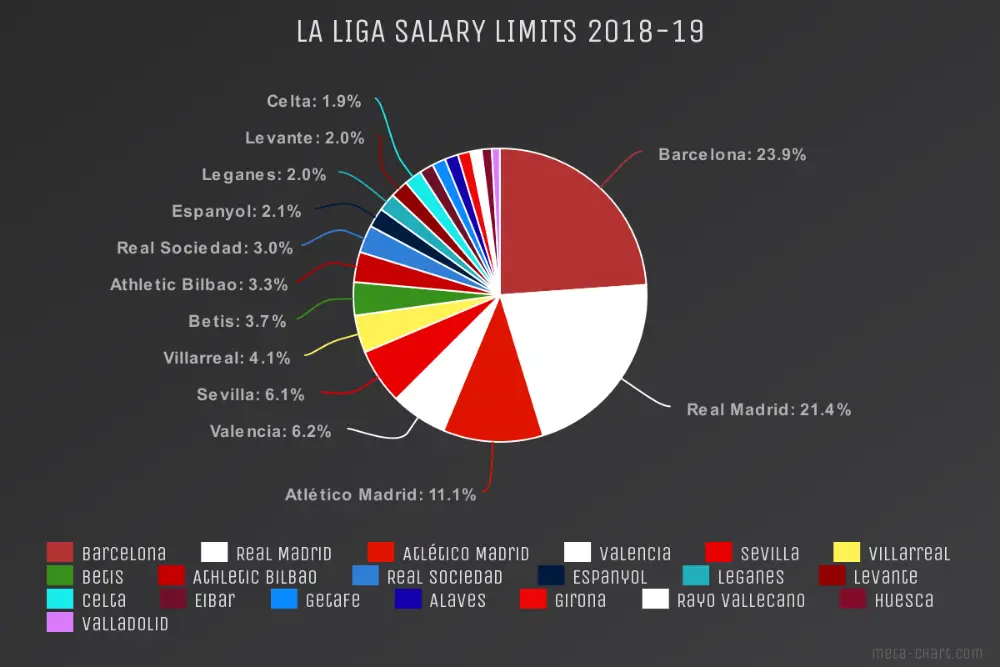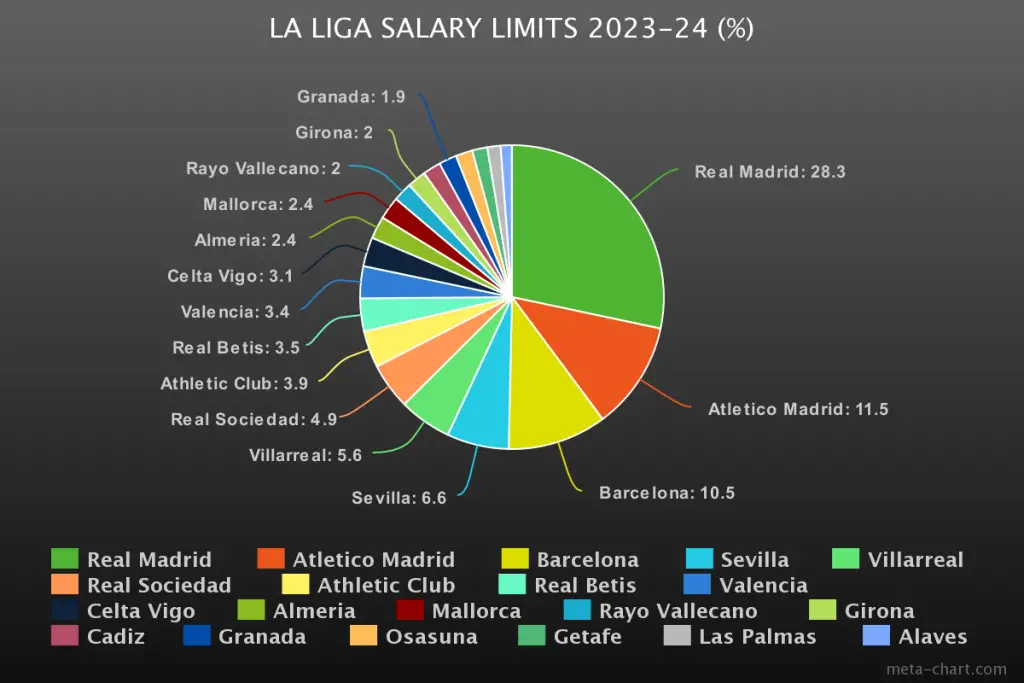
Spanish football is known for having some of the strictest financial limitations. For some observers, LaLiga’s salary cap has gone beyond sensible restrictions to ensure clubs stay in business, to the point where it is having a damaging impact on the product it is trying desperately to sell to the world.
The salary limit in LaLiga is the maximum, total amount each club can spend each year. It varies between clubs according to their vastly different revenue levels and the overall health of their books.
The exact process of calculating each team’s figure is a complicated business. Essentially, the salary cap in LaLiga works by ensuring clubs that have got themselves into financial trouble (such as Barcelona and Valencia in recent years) and have built up large debts, will see their spending limits slashed, even if their annual revenues are higher than other clubs who are in a better state overall.
There are many other variables and factors which come into play. In the case of Barcelona for example, their ability to sell assets and pull levers last summer, brought them some short-term leeway in 2022, but they’ve been much more restricted in the business they could do this summer with only €3.4m spent on transfers.
LaLiga salaries by team – Maximum limits 2023/24
| Club | Salary Limit (Euros) |
| Real Madrid | €727m |
| Atletico Madrid | €296m |
| Barcelona | €270m |
| Sevilla | €169m |
| Villarreal | €144m |
| Real Sociedad | €125m |
| Athletic Club | €101m |
| Real Betis | €90m |
| Valencia | €86m |
| Celta Vigo | €80m |
| Almeria | €62m |
| Mallorca | €61m |
| Rayo Vallecano | €52m |
| Girona | €52m |
| Cadiz | €49m |
| Granada | €48m |
| Osasuna | €47m |
| Getafe | €40m |
| Las Palmas | €35m |
| Alaves | €31m |
The above data relates to the summer 2023 transfer window, with the figures only released by LaLiga after its closure. Therefore this table essentially tells you what clubs could spend this summer rather than what they’ll be able to afford in the future.
Real Madrid are currently way clear of the rest with a salary limit of €727m, more than double that of rivals Atletico Madrid who are next on €296m. Fellow Champions League participants Barcelona, Sevilla and Real Sociedad also have limits of over €100m, as do Villarreal and Athletic Club.
Real Betis, Valencia and Celta Vigo have a decent advantage on the bottom ten sides where seven clubs are clustered together with limits between €47m and €62m. Even the club with the lowest budget (Alaves on €31m) still has more to spend than Elche (€24m) who have the highest limit in the Segunda Division.
How have LaLiga’s salary limits changed over the past five years?
| Club | Salary Limit 18/19 | Salary Limit 23/24 | Difference |
| Real Madrid | €567m | €727m | +€160m |
| Atletico Madrid | €293m | €296m | +€3m |
| Barcelona | €633m | €270m | -€363m |
| Sevilla | €163m | €169m | +€6m |
| Villarreal | €109m | €144m | +€35m |
| Real Sociedad | €81m | €125m | +€44m |
| Athletic Club | €88m | €101m | +€13m |
| Real Betis | €97m | €90m | -€7m |
| Valencia | €165m | €86m | -€79m |
| Celta Vigo | €51m | €80m | +€29m |
| Rayo Vallecano | €33m | €52m | +€19m |
| Girona | €37m | €52m | +€15m |
| Getafe | €39m | €40m | +€1m |
| Alaves | €39m | €31m | -€8m |
The above table only features clubs who were in the top division in 2018/19 and are also there this season given second tier limits are much lower.
The most striking changes come in the form of Barcelona and Valencia. In the case of the former, Barca’s limit today is less than half what it was five years ago towards the end of Josep Maria Bartomeu’s reign as president.
Valencia have also been severely hit, although they were down at around €31m during the 2021 summer transfer window which suggests Los Che may have turned a corner in terms of having more financial freedom in future windows, although under the current ownership, that doesn’t necessarily mean they will spend more.
The rest of LaLiga has mostly seen steady rises over the past five years which would be the very minimum that would be expected allowing for inflation. However that doesn’t necessarily mean that clubs are spending more as these are spending limits rather than actual spending figures.
For example the actual Real Madrid wage bill is reportedly €266m per year, only 37% of their limit. That’s still more than the total FC Barcelona salaries, but not by anything like the margin the spending limitations suggest.
Compared to the Premier League, and now faced with the money and power of the Saudi Pro League as a fresh rival, it’s safe to say that the Spanish top flight has fallen behind over this period in terms of its ability to compete for the best players and pay the kinds of transfer fees and wages that are needed to attract top talent.
Is LaLiga more competitive now?


LaLiga’s “big three” has a slightly smaller share of power overall when compared to five years ago in terms of their spending limits (50.3% now compared to 56.4% five years previously). The order has changed though given the Madrid clubs are now both ahead of Barcelona who had the highest salary limit in 2018/19.
That overall drop between those three clubs and the rest is largely a result of Barcelona’s financial struggles though. The two Madrid clubs now have a slightly higher share of the league’s total salary limit than they did in 2018/19 and the gulf between what the big and small clubs can spend is still huge.
The promoted clubs remain at a disadvantage in general as is fairly typical across the big leagues in Europe these days. It’s no surprise to see Alaves and Las Palmas are the teams with the lowest salary limits, although last season’s Segunda Division champions Granada have a higher limit than Getafe and even Osasuna who qualified for Europe last term.
Will that play out on the pitch? While it’s true that money does usually talk, it’s again worth remembering that these figures are not the same as the actual wage bills of each team and it’d be a big surprise were Granada to finish above Osasuna this season for example.
This data is though, a decent indicator of which clubs are operating within their means and which ones may have pushed the boat out a bit too much in recent transfer windows. That could have implications when January and next summer comes around.

